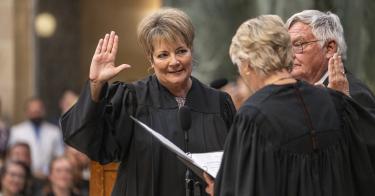On the first Monday of each October, the U.S. Supreme Court begins hearing cases for its new term. There’s no doubt that the decisions reached there reverberate throughout the country.
But as Chief Judge Jeffrey Sutton, who serves on the Sixth Circuit Court of Appeals reminded everyone in his book, 51 Imperfect Solutions, state constitutions provide many rights and remedies not available under the U.S. Constitution, and that state courts are charged with interpreting and enforcing those rights. (Of course, those rights cannot conflict with provisions of the U.S. Constitution or federal law).
With the U.S. Supreme Court’s Dobbs decision, which overturned Roe v. Wade and returned power “to the people and their elected representatives,” state constitutions and state supreme court decisions interpreting those constitutions have taken on new significance.
As a result of this renewed importance, focus has also turned to the ideological composition of state supreme courts and how justices to those courts are selected.
That’s where things get interesting.
>>> Ohio Ballot Initiative Is a Trojan Horse—and a “Right” to Abortion Is Just the Beginning
Selection methods vary widely among the states. In some states, the governor appoints the justices. In others, the legislature does. In others still, the people pick them through either partisan or nonpartisan elections. In fact, twenty-one states choose their Supreme Court justices through some form of direct election mechanism (not counting retention elections).
And as the people of Wisconsin recently found out, the consequences of these once low-profile, low-dollar affairs can be vast.
Wisconsin voters choose the seven justices who serve ten-year terms on their state’s supreme court via staggered nonpartisan elections—meaning that not all of the justices stand for election during each election cycle. But earlier this year, the ideological makeup of the closely divided court hung in the balance. And with only 36% of the state’s voting-age population participating—a large figure for this sort of election, but still only slightly more than one-third of potential voters—the court swung from having a conservative-leaning majority to a liberal-leaning one as a result of this election.
Already, the fallout from this ideological shift has been vast.
The newly formed liberal majority on the court voted to create a “Supreme Court Administrative Committee,” apparently designed to strip the current conservative chief justice, Annette Ziegler, of her power as the primary decisionmaker in several areas of procedure. In response, Ziegler labeled the new majority “four rogue members of the court” and called the changes a “raw exercise of overreaching power.”
But the consequences of judicial elections have been felt in other states too. Take North Carolina, for example.
There, a majority of liberal justices invalidated the state’s legislative maps as an inappropriate partisan gerrymander that, they claimed, violated the state’s constitution.
But after that decision, an election occurred, and the ideological makeup of the court changed. The newly constituted, more conservative court, withdrew its previous opinion and held that the North Carolina constitution does not prohibit partisan gerrymandering.
>>> State Abortion Laws Being Reversed as State Courts’ Ideological Compositions Change
This was likely the correct result but a complete 180 from the previous opinion. None of it would have happened, however, without the shift of power on the state Supreme Court.
The North Carolina case should remind us that state supreme courts across the country will play a crucial role in many election-related cases and will likely do so in the upcoming 2024 and 2026 elections.
After all, it was the scandal-plagued Supreme Court of Pennsylvania—a state that went for Trump in 2016—that extended the deadline for absentee ballots just before the 2020 election. Now, candidates running to sit on that court are exchanging barbs in sharply pointed attack ads.
In other words, these elections matter a lot.
What’s more, despite twenty-one states allowing voters to directly choose who will make these vastly important decisions on their highest courts, these races have remained among those with some of the lowest turnout numbers and some of the lowest fundraising amounts in their states—though that may be starting to change.
With crucial elections that could determine, or help to shift, the ideological makeup of state supreme courts in Georgia, Kentucky, Michigan, Minnesota, Nevada, Texas, and West Virginia, among others, in 2024, voters ought to pay attention to these races.
Doing so might not be as exciting as watching the Supreme Court hear new cases this October, but it could make all the difference as state supreme courts will continue to consider many important—and controversial—issues.
This piece originally appeared in Human Events





